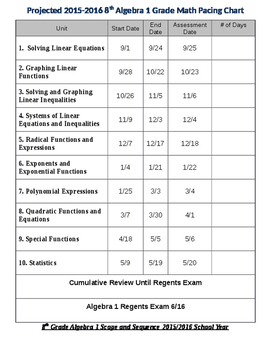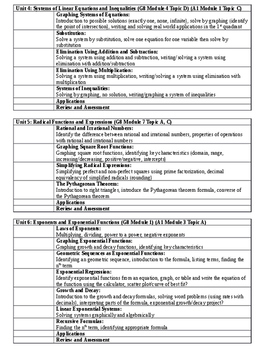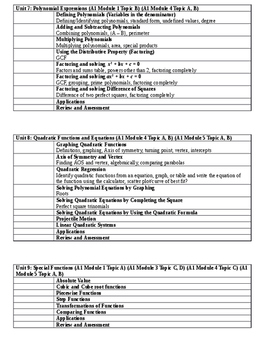Math Mods
108 Followers
Grade Levels
8th - 9th, Homeschool, Staff
Subjects
Resource Type
Standards
CCSSHSA-SSE.A.1
CCSSHSA-SSE.A.2
CCSSHSA-SSE.B.3
CCSSHSA-SSE.B.4
CCSSHSA-APR.A.1
Formats Included
- Word Document File
Pages
5 pages
Math Mods
108 Followers
Description
The projected scope and sequence provides a daily break down of the topics to be taught in Algebra. This scope and sequence is broken down in accordance with State Common Core Standards. Included is a pacing guide for the year. Descriptions include topics and daily allotted time to assure complete instruction before state regents exam (June).
Check out the great deal only entire Curriculum Bundle:
I have a lesson for each topic listed in the scope and sequence located below. Click to open:
Back to School (Week 1):
What Kind of Learner Are You? Learning Modalities Survey
What Pokemon Are You? Interactive Personality Survey
Ice Breaker Card Activity
Welcome Back Letter Algebra Common Core
TI-84 Graphing Calculator Lesson and Scavenger Hunt
Unit 1: Solving Linear Equations
Solving Two-Step Equations
Writing Algebraic Expressions and Equations
Solving Equations Using Distributive Property (English & Spanish)
Solving Equations Variables on Both Sides (English & Spanish)
Solving Linear Equations Quiz and Review
Solutions to Linear Equations (One, None or Infinite)
Solving Rational Equations Using LCD
Solving Literal Equations Day 1
Solving Literal Equations Day 2
Solving Linear Equations Applications
Unit 1 Assessment and Review (Solving Linear Equations)
Unit 2: Graphing Linear Functions
Writing Relations, Domain and Range
Define and Identify Functions
Functional Notation and Evaluating Functions
Graphing Linear Equations
Relations and Functions Quiz and Review
Applications of Linear Equations
Slope Intercept Form
Intercepts of Linear Equations
Calculating Slope
Average Rate of Change
Writing Equations Given Two Points
Writing Equations in Point Slope Form
Writing Linear Equations From Graphs
Arithmetic Sequences
Arithmetic Sequences Applications
Unit 2 Assessment and Review (Graphing Linear Functions)
Unit 3: Solving and Graphing Linear Inequalities
Interval and Set Notation
Solving and Graphing Inequalities in One Variable
Solving and Graphing Compound Inequalities Day 1
Solving and Graphing Compound Inequalities Day 2
Graphing Inequalities in Two Variables
Inequality Applications
Writing Inequalities From Graphs
Unit 3 Assessment and Review (Solving and Graphing Linear Inequalities)
Unit 4: Systems of Linear Equations and Inequalities
Graphing Systems of Linear Equations
Modeling Systems of Linear Equations
Solving Systems of Equations Using Substitution
Solving Systems of Equations Using Elimination (Addition and Subtraction)
Solving Systems of Equations Quiz and Review
Solving Systems of Equations Using Elimination (Multiplication)
Systems of Equations Word Problems
Solving Systems of Linear Inequalities
Solving Systems of Linear Inequalities Packet (Practice)
Unit 4 Assessment and Review (Systems of Linear Equations and Inequalities)
Unit 5: Radical Functions and Expressions
Rational and Irrational Numbers
Simplifying Radical Expressions
Pythagorean Theorem
Converse of Pythagorean Theorem
Graphing Square Root Functions
Radicals Quiz
Unit 6: Exponents and Exponential Functions
Introduction to Exponential Functions
Laws of Exponents Multiplication
Laws of Exponents Division
Laws of Exponents Power Rule
Negative and Zero Exponents
Graphing Exponential Functions
Exponents Quiz and Review
Check out the great deal only entire Curriculum Bundle:
I have a lesson for each topic listed in the scope and sequence located below. Click to open:
Back to School (Week 1):
What Kind of Learner Are You? Learning Modalities Survey
What Pokemon Are You? Interactive Personality Survey
Ice Breaker Card Activity
Welcome Back Letter Algebra Common Core
TI-84 Graphing Calculator Lesson and Scavenger Hunt
Unit 1: Solving Linear Equations
Solving Two-Step Equations
Writing Algebraic Expressions and Equations
Solving Equations Using Distributive Property (English & Spanish)
Solving Equations Variables on Both Sides (English & Spanish)
Solving Linear Equations Quiz and Review
Solutions to Linear Equations (One, None or Infinite)
Solving Rational Equations Using LCD
Solving Literal Equations Day 1
Solving Literal Equations Day 2
Solving Linear Equations Applications
Unit 1 Assessment and Review (Solving Linear Equations)
Unit 2: Graphing Linear Functions
Writing Relations, Domain and Range
Define and Identify Functions
Functional Notation and Evaluating Functions
Graphing Linear Equations
Relations and Functions Quiz and Review
Applications of Linear Equations
Slope Intercept Form
Intercepts of Linear Equations
Calculating Slope
Average Rate of Change
Writing Equations Given Two Points
Writing Equations in Point Slope Form
Writing Linear Equations From Graphs
Arithmetic Sequences
Arithmetic Sequences Applications
Unit 2 Assessment and Review (Graphing Linear Functions)
Unit 3: Solving and Graphing Linear Inequalities
Interval and Set Notation
Solving and Graphing Inequalities in One Variable
Solving and Graphing Compound Inequalities Day 1
Solving and Graphing Compound Inequalities Day 2
Graphing Inequalities in Two Variables
Inequality Applications
Writing Inequalities From Graphs
Unit 3 Assessment and Review (Solving and Graphing Linear Inequalities)
Unit 4: Systems of Linear Equations and Inequalities
Graphing Systems of Linear Equations
Modeling Systems of Linear Equations
Solving Systems of Equations Using Substitution
Solving Systems of Equations Using Elimination (Addition and Subtraction)
Solving Systems of Equations Quiz and Review
Solving Systems of Equations Using Elimination (Multiplication)
Systems of Equations Word Problems
Solving Systems of Linear Inequalities
Solving Systems of Linear Inequalities Packet (Practice)
Unit 4 Assessment and Review (Systems of Linear Equations and Inequalities)
Unit 5: Radical Functions and Expressions
Rational and Irrational Numbers
Simplifying Radical Expressions
Pythagorean Theorem
Converse of Pythagorean Theorem
Graphing Square Root Functions
Radicals Quiz
Unit 6: Exponents and Exponential Functions
Introduction to Exponential Functions
Laws of Exponents Multiplication
Laws of Exponents Division
Laws of Exponents Power Rule
Negative and Zero Exponents
Graphing Exponential Functions
Exponents Quiz and Review
Total Pages
5 pages
Answer Key
N/A
Teaching Duration
N/A
Report this resource to TPT
Reported resources will be reviewed by our team. Report this resource to let us know if this resource violates TPT’s content guidelines.
Standards
to see state-specific standards (only available in the US).
CCSSHSA-SSE.A.1
Interpret expressions that represent a quantity in terms of its context.
CCSSHSA-SSE.A.2
Use the structure of an expression to identify ways to rewrite it. For example, see 𝘹⁴ – 𝘺⁴ as (𝘹²)² – (𝘺²)², thus recognizing it as a difference of squares that can be factored as (𝘹² – 𝘺²)(𝘹² + 𝘺²).
CCSSHSA-SSE.B.3
Choose and produce an equivalent form of an expression to reveal and explain properties of the quantity represented by the expression.
CCSSHSA-SSE.B.4
Derive the formula for the sum of a finite geometric series (when the common ratio is not 1), and use the formula to solve problems. For example, calculate mortgage payments.
CCSSHSA-APR.A.1
Understand that polynomials form a system analogous to the integers, namely, they are closed under the operations of addition, subtraction, and multiplication; add, subtract, and multiply polynomials.





